Resetting the network card settings. Reset network settings.
sfc / scannow
HKLM \ SYSTEM \ CurrentControlSet \ Services \ LanmanServer
HKLM \ SYSTEM \ ControlSet001 \ Services \ LanmanServer
HKLM \ SYSTEM \ ControlSet002 \ Services \ LanmanServer
Sometimes, it happens, the Internet connection settings get lost or simply does not want to connect to the network (does not receive an IP address via DHCP). Similar problems may arise as a result of the operation of some malware(viruses). You can torture those for a long time. support from your provider or call a specialist at home. You can try to fix the problem yourself.
To reset TCP / IP in operating rooms Windows systems NT (2000 / XP / Seven) exists special program netsh.exe.
netsh.exe- (Network Shell) allows you to configure the network parameters.
Some dirty viruses will get into WinSock and dirty.
Symptoms:
- The download speed of files over TCP is very low (while over UDP it can download quickly);
- When you turn on the computer for a while, a couple of minutes, the Internet works fine, but then it disappears completely (the speed drops to 0);
- The Internet works and the download speed is normal, but the uploaded file turns out to be broken because it is not downloaded completely (most likely the virus intercepts some of the packets during transmission, but sends a notification to the source about the successful receipt of all packets).
In addition to viruses, you can also "break" your Internet connection (or "shut it down")
Some examples:
- The computer does not receive an ip-address automatically (via DHCP);
- IP addresses are pinged but not pinged by name;
- The computer receives an IP address of such a pattern 169.254. *. *;
If the viruses are cleaned, then you can proceed with the recovery. ATTENTION! The following procedures will reset the network settings. I highly recommend rewriting the settings.
What would reset Winsock:
If the first command does not solve the problem, you can reset the TCP / IP stack to "factory" settings:
Ibid in command line, enter the command:
netsh int ip reset c: \ resetlog.txt
In this case, the reset log will be saved in the root of the C: \ drive; if you omit the c: \ prefix, the log will be saved in the current directory. After that, you should restart your computer.
After using this command, the following register branches will be reset to the "factory" ones:
SYSTEM \ CurrentControlSet \ Services \ Tcpip \ Parameters \
SYSTEM \ CurrentControlSet \ Services \ DHCP \ Parameters \
You can use these commands together one after the other. By the way, they also dump the DNS cache.
About DNS Cache Issues: For example, the site has moved to another hosting, as a result, its IP address has changed. And since you have not quite fresh data in the cache, when you enter the site name, you will be taken to the old IP address, where the site no longer exists.
In order not to reset all settings, try the command ipconfig / flushdns If it doesn't help, use netsh int ip reset resetlog.txt- this is guaranteed to help and reset everything it touches network connections.
When uninstalling Kaspersky Lab products using standard Windows tools(Control Panel → Add / Remove Programs) errors may occur, as a result of which the program will not be removed or will be partially removed. To completely remove a Kaspersky Lab product, use the kavremover utility.
The uninstall utility completely removes the following Kaspersky Lab products:
- Kaspersky Safe Kids (all versions)
- Kaspersky Secure Connection
- Kaspersky Small Office Security for Personal Computer/ File Server (all versions)
- Kaspersky Total Security(all versions)
- Kaspersky PURE / CRYSTAL (all versions)
- Kaspersky Anti-Virus (from version 2009 and above)
- Kaspersky Internet Security(from version 2009 and up)
- Kaspersky Free
- Kaspersky Password Manager (all versions)
- Kaspersky Fraud Prevention for Endpoint (all versions)
- AVP Tool driver
- Endpoint Sensor
- Kaspersky Security Scan (all versions)
- Kaspersky Endpoint Security for File Servers and Workstations for Windows (starting from version 8 and higher)
- Kaspersky Anti-Virus 6.0 / 6.0 R2 for Windows Workstations
- Kaspersky Anti-Virus 6.0 / 6.0 R2 for Windows Servers
- Kaspersky Anti-Virus 6.0 FS MP4
- Kaspersky Anti-Virus 6.0 SOS MP4
- Kaspersky Anti-Virus 6.0 WKS MP4
- Kaspersky Anti-Virus 8.0 for Windows Servers Enterprise Edition / MR1 / SP2
- Kaspersky Security 10 for Windows Server
- Nifty Security 24 Internet Security / Nifty Security 24 Internet Security 2013
- KTFS for Windows 3.0
- Kaspersky Anti-Ransomware Tool (KART) for Business (all versions)
- Kaspersky Anti Targeted Attack (KATA) Platform 2.0
- Kaspersky Embedded Systems Security 2.0
If you uninstall a product using the kavremover utility, the license information is deleted along with it. Make sure you save your product key or activation code so you can reuse it.
Working with the utility
For complete removal program, follow these steps:
- Download the kavremvr.zip archive and then unpack it (for example, using the WinZip archiver program). Or download executable file kavremvr.exe.
- Run the kavremvr.exe file by double clicking on it with the left mouse button.
- Read the License Agreement of Kaspersky Lab. Read the agreement carefully and, if you agree with all of its clauses, click I agree.
- In the window Kaspersky Lab Products Remover enter the security code in the empty field, which is shown in the picture. If the code is not clearly visible, to re-generate the code, click on the refresh button to the right of the picture.
- Select from the menu Found the following products a Kaspersky Lab application that was installed on your computer. Click on Delete... If several Kaspersky Lab products are installed on the computer, select and uninstall them one by one. You can select the program to uninstall from the list of all products supported by the uninstall utility, for this:
- Run the kavremvr utility via the command line in manual selection mode, with the nodetect parameter:
- kavremvr.exe --nodetect.
- Select from the list the desired program and delete it. If there are several such programs, uninstall them one by one.
![]()
- Removal may take some time. Wait for the dialog box to appear informing you that the product has been successfully removed and click OK.

- Reboot your computer.
By default, a log of deletion of the view is saved in the folder where the utility is located. kavremvr xxxx-xx-xx xx-xx-xx (pid xxxx) .log where you can view the version of the utility:

Additional information for users of business products
When uninstalling Kaspersky Endpoint Security 10/10 CF1 / 10 SP1 MR2 for Windows, you may need to specify a password. For this:
- Run the utility from the command line with the parameter
- kavremvr.exe --password-for-uninstall:% PASSWORD% --MSIPARAM: KLLOGIN =% login%, where:
- % login%- is the username for the respective product;
- % password% - this is the password for the corresponding product.
kavremvr.exe --password-for-uninstall: 123 --MSIPARAM: KLLOGIN = Ivanov
- Select the required program from the list.
During the operation of the program, errors may occur:
Error 1001
Products that cause an error when uninstalling: Kaspersky Endpoint Security 10/10 CF1 / 10 SP1 MR2
Cause: FDE-encrypted drives or drives scheduled for FDE encryption were detected.
Error 1002
Products that cause an error when uninstalling: Kaspersky Network Agent 10 CF1, Kaspersky Endpoint Security 10/10 CF1 / 10 SP1 MR2
Reason: a password for uninstallation was set for the specified products, but the user did not enter the password in the command line.
Error 1003
An error can occur when uninstalling any Kaspersky Lab product.
Reason: KAVRemover is launched from a directory that contains not ASCII characters from a localization other than the current Windows localization. For example, such a situation may arise if the username is specified in non-Latin letters, and the user launches the utility from his desktop.
Removing Network Agent on the Administration Server will cause the server to become inoperable, so the option to uninstall Network Agent is removed in new version kavremover.
Service articles: Service utility kl1_log for collecting information in Kaspersky Lab applications
Service Specialist technical support Kaspersky Lab may ask you to get the utility log kl1_log for information about the network operation on your computer.
To get the utility log kl1_log, follow these steps:
- Download the archive kl1_log.zip and save it to your Desktop or any other convenient place.
- Unpack the archive (for example, using the WinZip archiver program).
- Disable self-defense of a Kaspersky Lab product:
- Kaspersky Small Office Security 5 for Personal Computer / File Server
- Kaspersky Small Office Security 4 for Personal Computer / File Server
- Open the folder kl1_log.
- Run the file kl1med_on.reg.
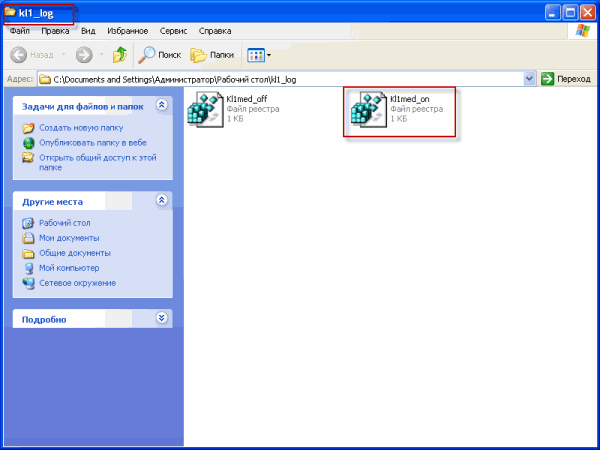
- Yes in the window Registry editor.
- In case of successful completion of data entry into the register, in the window Registry editor a message will appear: " Data from "<путь к файлу>\ Kl1med_on.reg "have been successfully entered into the registry". Click OK.

- Reboot your computer.
- Reproduce the problem situation.
- Run the file kl1med_off.reg.
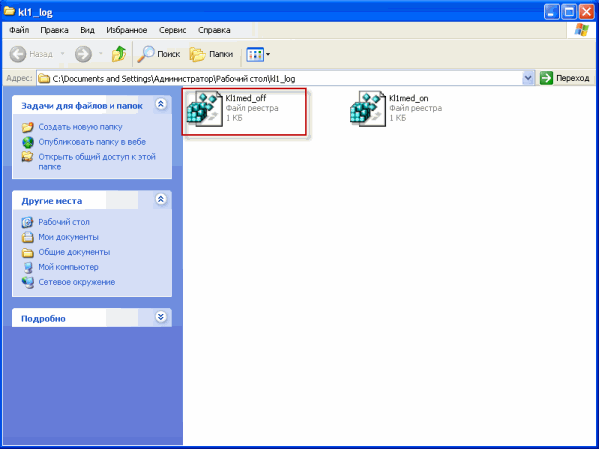
- Confirm that you really want to add information to the registry by clicking Yes in the window Registry editor.
- In case of successful completion of the process of entering data into the register, in the window Registry editor a message will appear: "Data from"<путь к файлу>\ Kl1med_off.reg "have been successfully entered into the registry"... Click on OK.

The log file will be saved to the root of the disk C: with a unique name _ids.

Send a request to Kaspersky Lab Technical Support via the My Kaspersky portal, attaching a log file to the request _ids.log... You can find information on how to work with My Kaspersky on the FAQ page for My Kaspersky.
Service articles: Scanning a computer, saving a log and launching a script using the AVZ utility
AVZ utility is designed to collect information about the computer, analyze running processes for the presence of malicious code that is not yet known to Kaspersky Lab and is not detected by the current anti-virus databases.
To run the utility, follow these steps:
- Unpack the archive (for example, using the WinZip archiver program).
- Open the avz4 folder.
- Run the avz.exe file.

- Select the menu File → Standard scripts.

- Check the box Script for updating, disinfecting and collecting information. Kaspersky Lab.
- Click on Execute marked scripts.
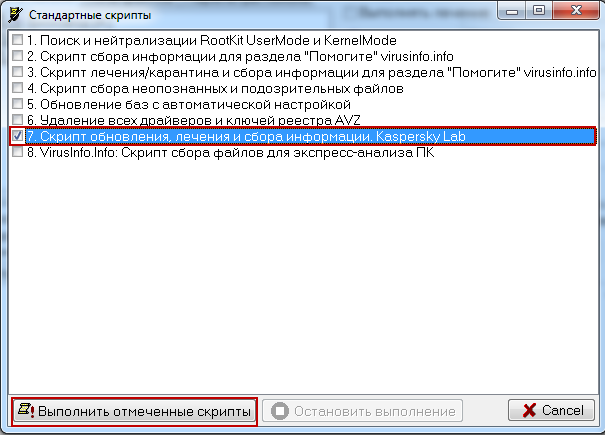
- Click on Yes.
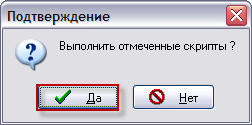
- During the execution of the script, the computer will be restarted. Save all editable documents and click OK to run the script.
- Wait until the process of scanning and disinfecting the system is completed. In the window Information click OK.
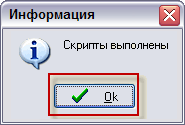
After the script completes, the computer will reboot, and the scan log will be saved in the avz4 folder in the LOG subfolder in the form of two files:
- KL_syscure.htm
- avz_sysinfo.htm in the archive folder KL_syscure.zip
Service articles: How to disable Recovery system files
For Windows users system recovery is available after a malfunction occurs.
However, in some cases, it may be necessary to temporarily disable this feature. For example, to remove from a folder _Restore infected files detected by a Kaspersky Lab product. To disable System Restore, follow the recommendations:
What to do after disabling System Restore
After disabling System Restore, run a full scan of your computer using a Kaspersky Lab product:
- How to run a full scan in Kaspersky Small Office Security 5.0 for File Server
- How to run a full scan in Kaspersky Small Office Security 5.0 for Personal Computer
- How to run a full scan in Kaspersky Small Office Security 4.0 for File Server
- How to run a full scan in Kaspersky Small Office Security 4.0 for Personal Computer
After completing the disinfection or deletion of infected files by a Kaspersky Lab product, re-enable System Restore.
Service articles: Exporting registry keys to a file and recovering from a file in Windows Vista / 7
In some cases (for example, when a computer is infected with a virus), you may need to delete / edit some sections system registry... Before editing the system registry, export the entire registry or its sections to which changes will be made (create backup). This will restore the previous state of the system registry if necessary.
1. Exporting registry keys to a file
To export a registry key to a file, follow these steps:
- In the lower left corner of the screen, click on the button Start.
- In the search bar, enter regedit and press the key on the keyboard Enter.
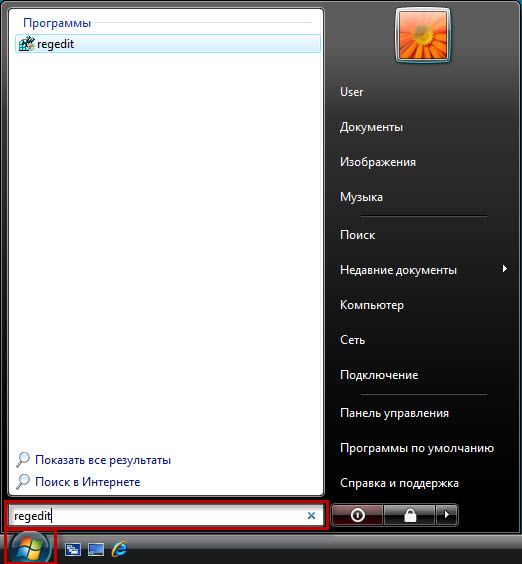
- Enter the administrator password if required.
- In the window User Account Control click on the button Proceed.
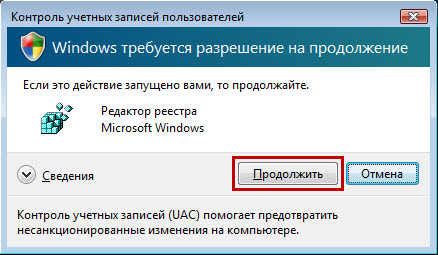
- On the left side of the window Registry editor click right click mouse on the registry key that needs to be exported and in context menu select item Export.
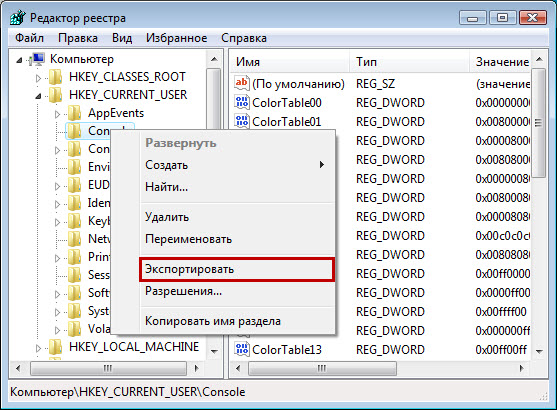
- In the window Exporting a registry file specify the path and file name in which the selected section will be saved.
- Click on the button Save.
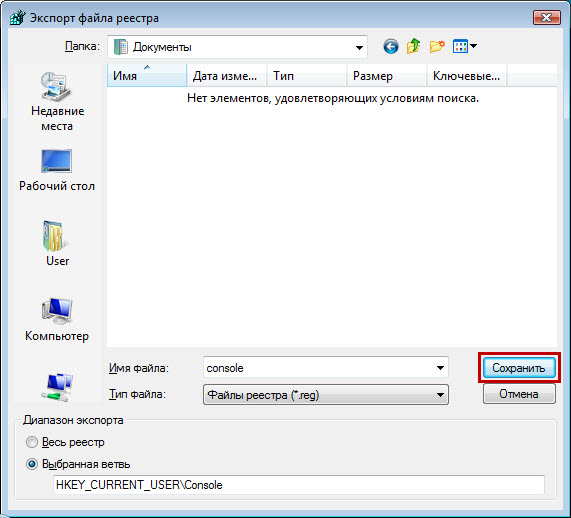
- Close the window Registry editor.
2. Recovering registry keys from a file
To restore a registry key from a file, follow these steps:
- Double-click the left mouse button on the file to which the registry key was previously saved.
- Confirm the launch of the file, if required. For this in the window User Account Control click on the button Proceed.
- In the window Registry editor click on the button Yes.
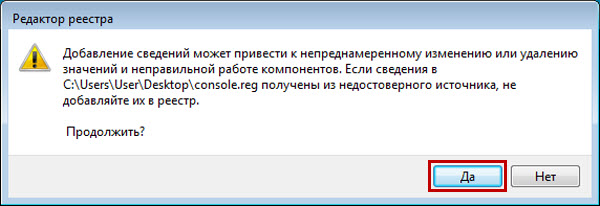
- In the window Registry editor a message appears stating that the data has been entered into the registry. Click on the button OK.

Service articles: How to restore an activation code for a Kaspersky Lab product
If the activation code was lost or deleted by mistake, you can restore it in the following ways:
Electronic version
If you purchased an electronic version of the product in an online store, find the activation code in the letter sent from the online store to the address Email specified by you when placing an order. If the letter has been deleted, to restore the activation code, contact the online store, specifying the following information in the request:
- Purchase date.
- Information about the owner (name, e-mail address).
- The number of the online order sent in the confirmation email that was sent to you after purchasing the program.
If electronic version the product was purchased from the online store http://www.kaspersky.com/store, then send an email with the above information to email address [email protected].
Boxed version
If you purchased a boxed version of the product, to restore the activation code, send a request describing the situation to Kaspersky Lab Technical Support on the portal
Windows 10 - includes new function called Network Reset, which will quickly return the default network settings for all network adapters on the system. It can be very helpful to reset your network settings if you are having connectivity issues, especially after removing malware.
Network Reset will allow you to uninstall and reinstall everything network adapters and also install other network components back to the initial settings. You may need to reinstall another network software after that, for example, VPN client software or virtual switches.
Open the settings WinKey + I and press Network and Internet
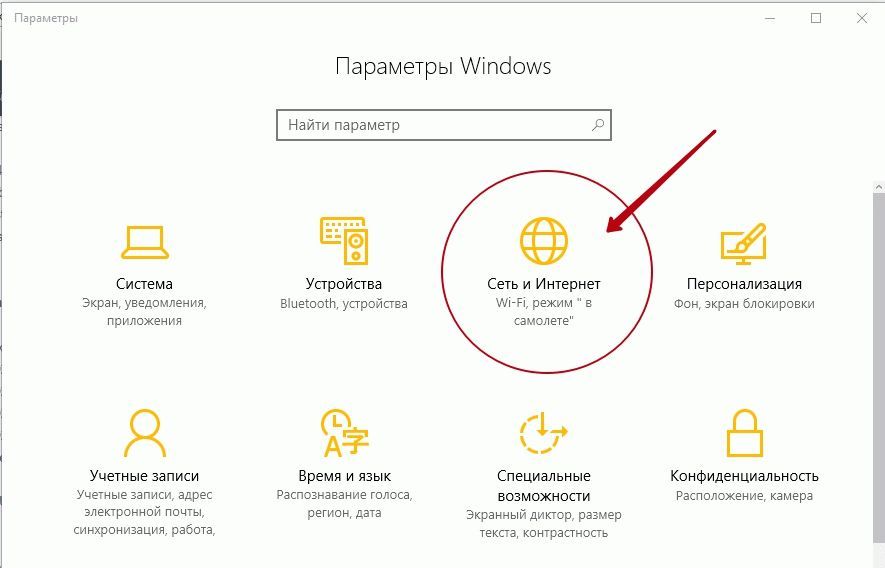
Click on State

On the status page, there are several links to correct your network configuration. One of them is the diagnostic package "Network Troubleshooter", which runs a network scan on your system, will suggest fixes if needed.
If for some reason the "Network Troubleshooter" does not find any errors and cannot fix your connection, you must Network reset.

Since Network Reset resets all NICs to their original settings, Winsock, etc. If you have a custom network configuration, please make a note of your settings. Also, write down your Wi-Fi configuration and associated passwords before resetting. After that, press the button Reset Now.
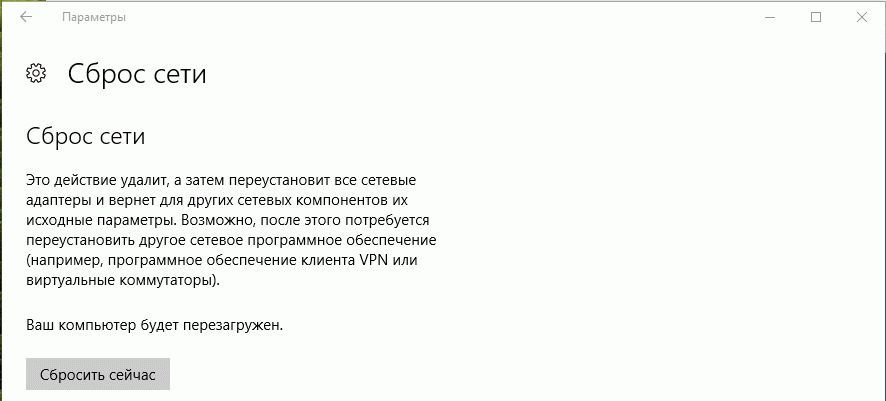
Click the button Yes... Windows 10 will reset the network adapters and reset Winsock.

Note: Windows10 will automatically restart after 5 minutes.
Previously, the user had to run these commands manually to clear the network adapter configuration and reset Winsock.
- netcfg -d
- netsh winsock reset
Now you know how to do a Network Reset in Windows 10.
Good afternoon, dear readers, we continue to study with you OS company Microsoft, last time we discussed the issue of how the error of a device descriptor request failure is solved, today we continue to learn to look for and solve problems in the top ten, and we will analyze the issue of how discharge network settings windows 10 redstone, believe me, there are situations when this knowledge restores the business of a critical service and saves a bunch of nerve cells.
When network settings need to be reset
Before doing something you need to understand and realize why you are doing this, this is the very first rule in any business, now it is difficult to imagine our life without computers and the Internet, they have greatly simplified it. Technology, like people, is not without flaws and can also work poorly or even stop performing its tasks altogether. Since computers communicate among themselves by means local area networks, which is the Internet, then there are times when there is a problem in it, simple example there may be a case when there are no windows 10 network protocols and one of the solutions was exactly resetting to the default network settings.
How to reset network settings windows 10
With the release of windows 10 anniversary update, as you are already used to, it brought not only new bugs, but also useful functionality that simplifies resetting the network settings of windows 10 redstone, and, what is cool, this is done with one click of the mouse button, bravo to Microsoft. Now you no longer need to explain to the user how reset network settings via command line(we will look at it later, for the sake of the integrity of the picture), what a torment it was, especially for the representatives of technical support.
And so let's get started and reset the network and Internet settings to Windows settings 10 redstone, I want to note that the steps taken will return all your network settings to their initial state, so it is possible if you have manual settings Internet, then you will have to restore everything manually by setting the appropriate parameters:
- ip address
- VPN connection
I also want to note that resetting the network settings of windows 10 is not a panacea for everything, and it is not a fact that it will fix the problem with the Internet, and may even create additional difficulties for the user, in the form of the reconfiguration described above.
Everything from words to practice, since resetting the network settings of windows 10, do the following, click Start and select the Settings item.

As a result, you will see a window Windows settings, it can also be called by the keyboard shortcut WIn + I (these are the hotkeys for windows 10). Select the item Network and Internet.

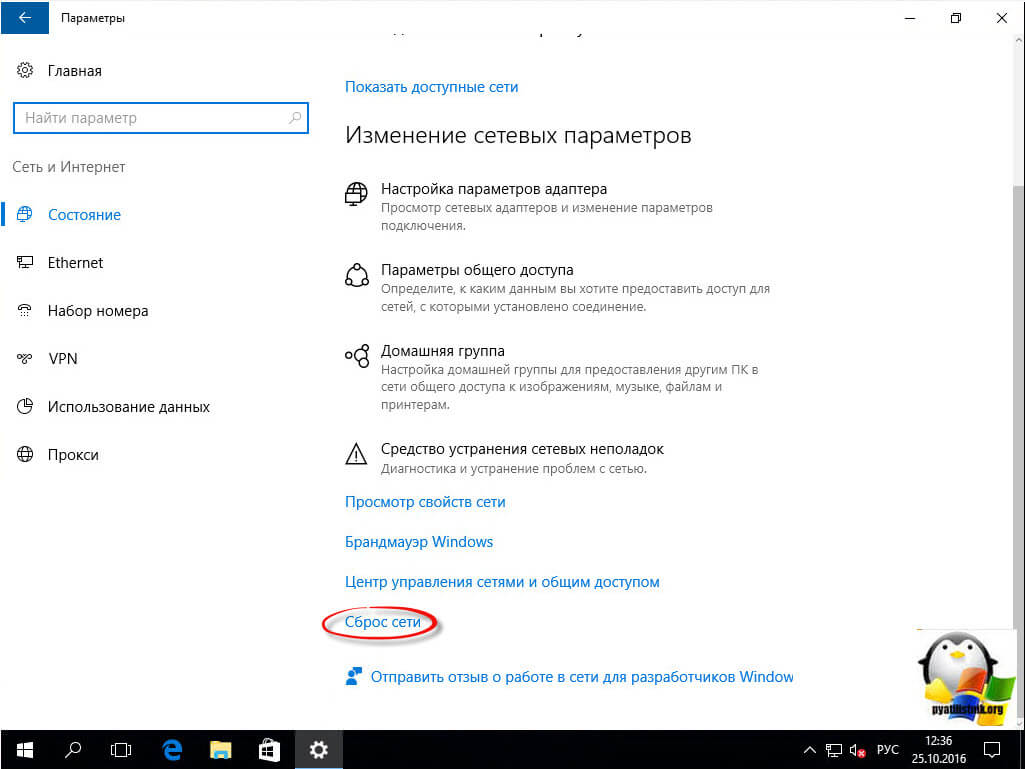
We press reset now, please note that your computer must reboot.
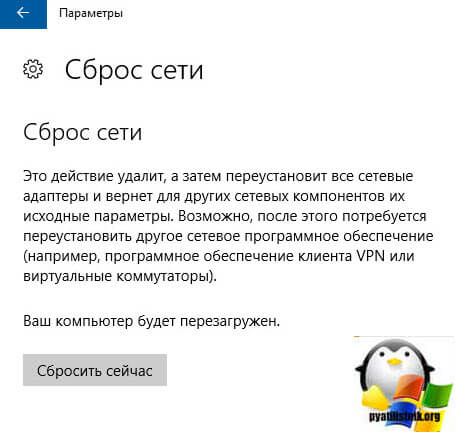
We confirm our action with the Yes button and start resetting the network settings of windows 10 redstone.
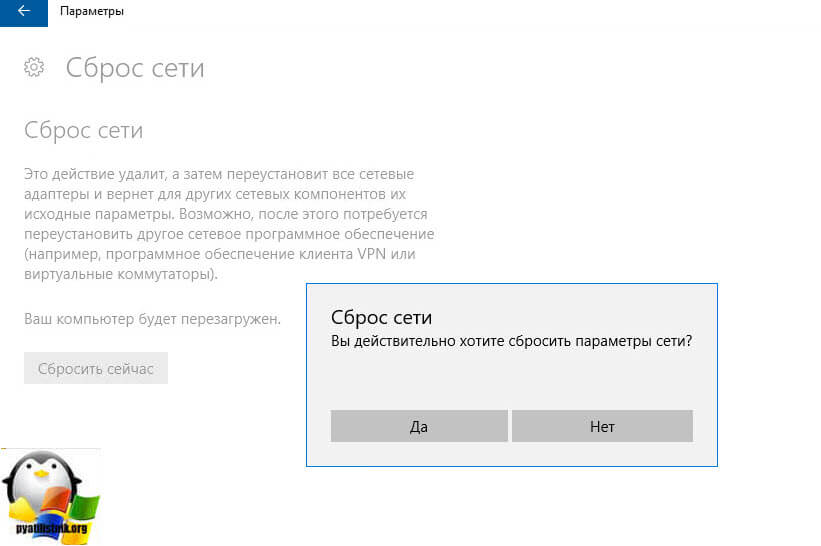
As a result, you will see a command line in which we run the familiar utility netsh, I will talk about it below.
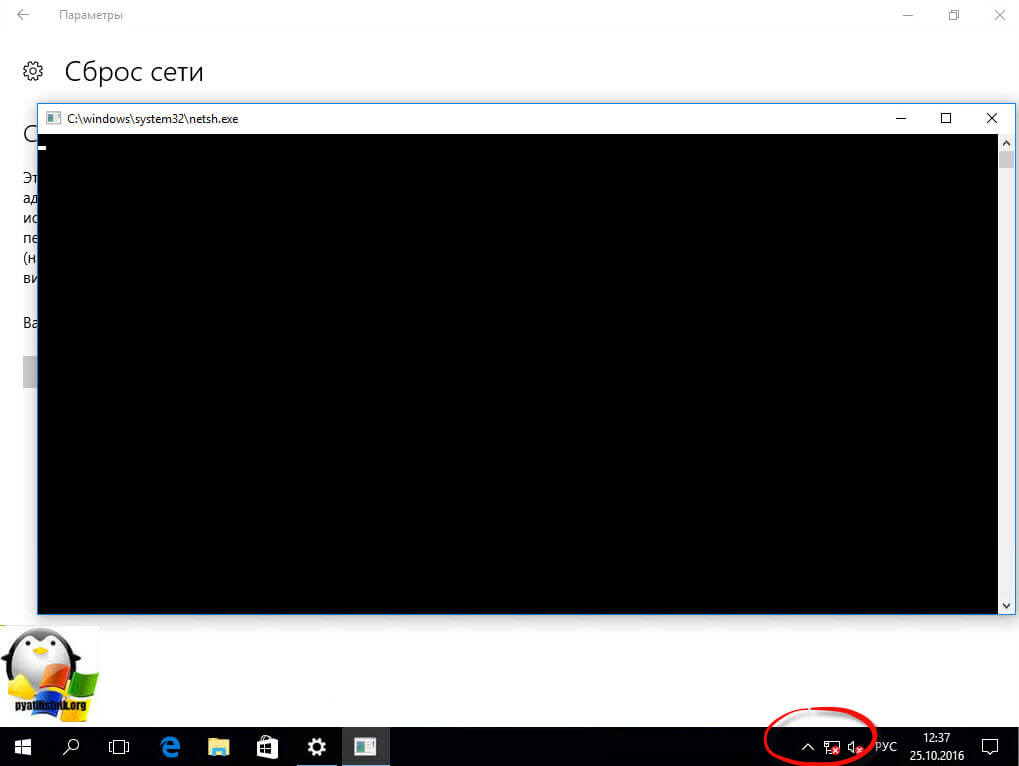
Do not forget, then restart your computer. During the reset of the network connections, all network adapters are removed from Windows 10, and then the reinstallation of all devices available to it begins, so that if before your system could not automatically detect, for example, WIFI or a network adapter , then you may encounter this again
Resetting network settings via command line
Resetting the network settings of windows 10, you can do it the old fashioned way from the command line, for the command line running as administrator, I already told you this d note
In the instructions on this site related to problems with the Internet, such as, and in others, among the solutions, there is always a reset of the Windows network settings (DNS cache, TCP / IP protocol, static routes), usually using the command line ...
V Windows update 10 1607 introduced a function that simplifies the steps to reset the settings of all network connections and protocols and allows you to do this, literally, with the push of a button. That is, now, if any problems arise with the operation of the network and the Internet, and provided that they are caused precisely by incorrect settings, these problems can be solved very quickly.
Reset network and Internet settings in Windows 10 settings
When performing the steps below, keep in mind that after you reset the Internet and network settings, all network settings will return to the state they were in when they were originally Windows installation 10. That is, if your connection requires entering any parameters manually, they will have to be repeated.
To reset network settings, network adapter settings and other components in Windows 10, follow these simple steps.
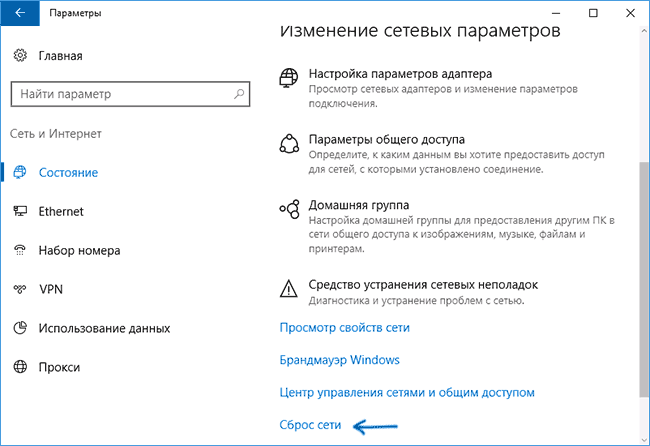
After pressing the button, you will need to confirm the reset of the network settings and wait a while for the computer to restart.
After rebooting and connecting to the network, Windows 10, as after installation, will ask you if this computer should be found on the network (i.e. your public or private network), after which the reset can be considered complete.
Note: The process removes all network adapters and reinstalls them on the system. If you previously had problems installing drivers network card or Wi-Fi adapter, there is a possibility that they will be repeated.
 Bugs in Singularity?
Bugs in Singularity? Just Cause 2 crashes
Just Cause 2 crashes Terraria won't start, what should I do?
Terraria won't start, what should I do?